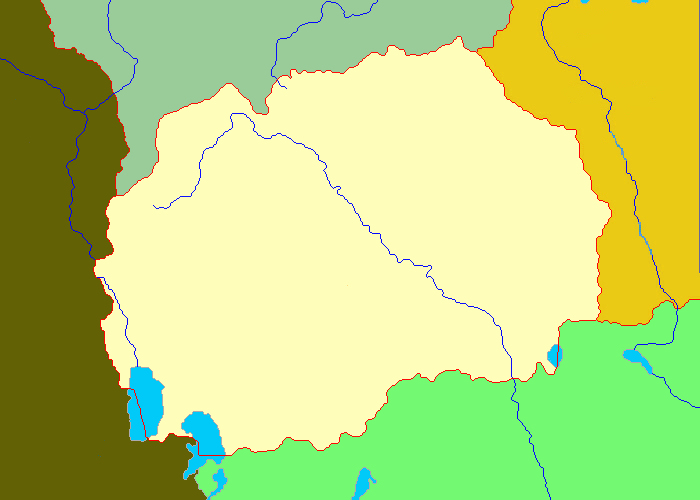North Macedonia

Historie
North Macedonia geographically roughly corresponds to the ancient Kingdom of Paeonia, which was located immediately
north of the ancient Kingdom of Macedonia. Paeonia was inhabited by the Paeonians, a Thracian people, whilst the
northwest was inhabited by the Dardani and the southwest by tribes known historically as the Enchelae, Pelagones,
and Lyncestae; the latter two are generally regarded as Molossian tribes of the northwestern Greek group, whilst the
former two are considered Illyrian.
In the late 6th century BC, the Achaemenid Persians under Darius the Great conquered the Paeonians, incorporating it within
their vast territories. Following the loss in the Second Persian invasion of Greece in 479 BC, the Persians eventually
withdrew from their European territories.
Philip II of Macedon absorbed the regions of Upper Macedonia (Lynkestis and Pelagonia) and the southern part of Paeonia
(Deuriopus) into the Kingdom of Macedon in 356 BC. Philip's son Alexander the Great conquered the remainder of the region
and incorporated it in his empire, reaching as far north as Scupi, but the city and the surrounding area remained part of Dardania.
After the death of Alexander, Celtic armies began to bear down on the southern regions, threatening the kingdom of Macedon. In 310 BC,
they attacked the area, but were defeated.
The Romans included most of the region in their province of "Macedonia", but the northernmost parts (Dardania) lay
in "Moesia".
Slavic tribes settled in the region by the late 6th century AD. They were led by Pannonian Avars. The Slavs settled
on places of earlier settlements and probably merged later with the local populations to form mixed Byzantine-Slavic communities.
Historical records document that in c. 680 AD a "Bulgar ruler" called Kuber led a group of largely Christians called
"Sermesianoi" who were his subjects, and they settled in the region of Pelagonia. During the rule of Presian I (836–852) the
Bulgarian Empire expended there control over the Slavic tribes in and around Macedonia.
After several decades of almost incessant fighting, Bulgaria came under Byzantine rule in 1018 and was incorporated as "Theme of
Bulgaria". By the late 12th century, Byzantine decline saw the region contested by various political entities, including a brief
Norman occupation in the 1080s.
In the early 13th century, a revived Bulgarian Empire gained control of the region. Plagued by political difficulties, the empire
did not last, and the region came once again under Byzantine control in the early 14th century.
In the 14th century, it became part of the Serbian Empire (1346–1371). The Kingdom of Prilep (1371–1395) was one of
the short-lived states that emerged from the collapse of the Serbian Empire, which was seized by the Ottomans at the end of the 14th
century. Gradually, all of the central Balkans were conquered by the Ottoman Empire and remained under its domination for five
centuries as part of the province of Rumelia.
Following the two Balkan Wars of 1912 and 1913 and the dissolution of the Ottoman Empire, most of its European-held territories
were divided between Greece, Bulgaria and Serbia. Almost the territory that was to become North Macedonia was annexed by Serbia conforming
to the Treaty of Bucharest (1913). However, Strumica region was passed to Bulgaria.
During the First World War, most of today's North Macedonia was part of the Bulgarian occupied zone of Serbia after the
country was invaded by the Central Powers in the fall of 1915.
After the capitulation of Bulgaria and the end of the First World War, the area returned under Belgrade control as part of the newly formed
Kingdom of Serbs, Croats and Slovenes. Also after the Treaty of Neuilly-sur-Seine, the Strumica region was annexed to
Serbian Macedonia in 1919.
In 1929, the Kingdom was officially renamed the Kingdom of Yugoslavia, and divided into provinces called "banovinas". South
Serbia, including all of present-day North Macedonia, became the Vardar Banovina of the Kingdom of Yugoslavia.
During World War II, Yugoslavia was occupied by the Axis powers from 1941 to 1945. The Vardar Banovina was divided between Bulgaria
and Italian-occupied Albania.
Following World War II, Yugoslavia was reconstituted as a federal state under the leadership of Tito's Yugoslav Communist Party. When
the former Vardar province was established in 1944, most of its territory was transferred into a separate republic while the northernmost
parts of the province remained with Serbia. In 1946, the new republic was granted federal status as an autonomous "People's Republic
of Macedonia" within the new Socialist Federal Republic of Yugoslavia. In the 1963 Constitution of Yugoslavia it was slightly
renamed, to bring it in line with the other Yugoslav republics, as the Socialist Republic of Macedonia.
In 1990, the form of government peacefully changed from socialist state to parliamentary democracy. The first multi-party elections were
held on 11 and 25 November and 9 December 1990 and Kiro Gligorov became the first democratically elected president of the
Republic of Macedonia on 31 January 1991. Bulgaria was the first country to recognize the new Macedonian state under its constitutional
name. However, international recognition of the new country was delayed by Greece's objection to the use of what it considered a
Hellenic name and national symbols, as well as controversial clauses in the Republic's constitution, a controversy known as the
Macedonia naming dispute. To compromise, the country was admitted to the United Nations under the provisional name of "the former
Yugoslav Republic of Macedonia" on 8 April 1993.
In June 2018, the Prespa agreement was reached between the governments of Greece and the then-Republic of Macedonia to rename the
latter the Republic of North Macedonia, or North Macedonia for short. This agreement, after it had been accepted by the respective
legislatures of both countries, came into effect on 12 February 2019, thus ending the disputes.
I have visitted North Macedonia several times
The pictures of these trips, are not yet available; i have to digatalize them first.
Please let me know when you're having questions.
i would be pleased to help you.
Things to do and other tips
